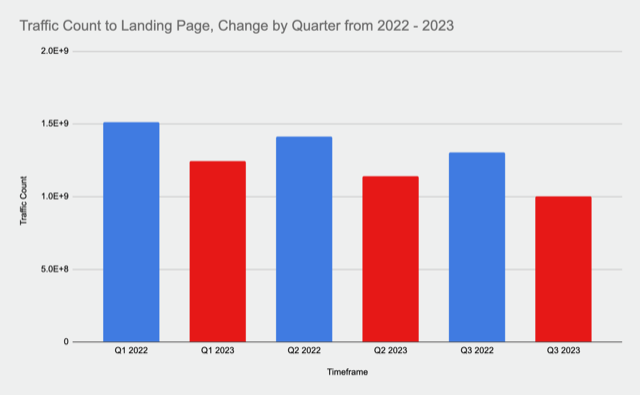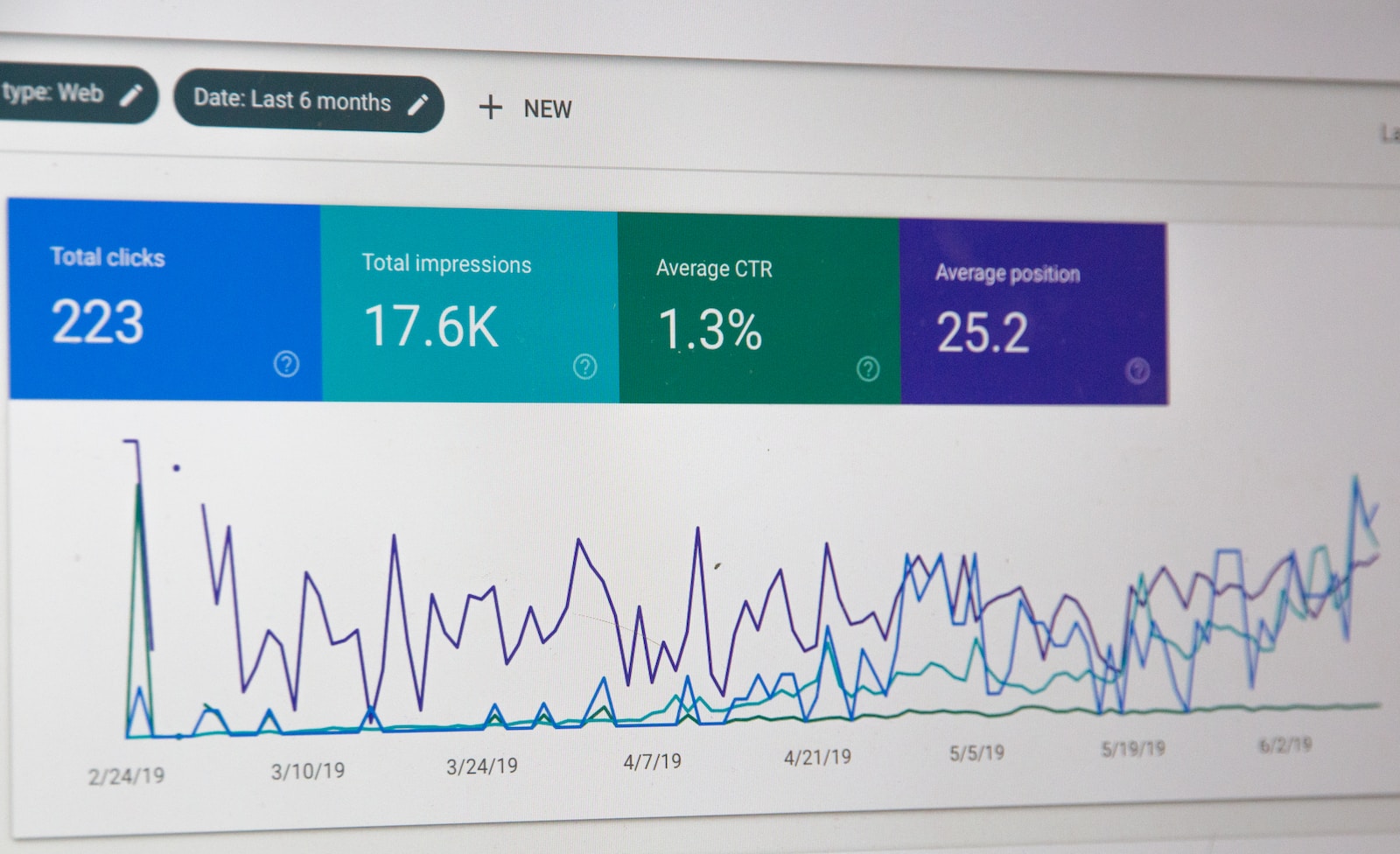Traditional search marketing has been a staple in the digital marketer’s toolkit for over a decade. Entire teams were focused on growing a successful SEO presence, chasing the coveted top spots on Google for more clicks, traffic, and more sales. But things have changed.
In a few short months, AI has altered how people search, where they search, and what they expect out of a search. This means that marketers who plan to continue optimizing their organic search programs in the way they always have are in for a rude awakening.
Globally, Google searches are on the decline year over year. People are turning to conversational AI search tools like ChatGPT, Perplexity, and Waldo to get their questions answered faster, with less effort. Why search on Google and click through three articles, when conversational AI search tools will gladly serve up one satisfying response curated from the best of the web?
We’re now in a new inning when it comes to search marketing – one where the old rules of the game no longer apply. And nobody knows what the new rules are because we’re in the middle of writing them.
As organic search finds a new baseline, marketers need to prepare for challenges ahead and focus on what they can control. One available tool: getting the most out of any available traffic through conversion optimization.
As a leading provider of AI-backed conversion tools for marketers, we’re watching these shifts closely. If you’re a marketer looking to get ahead of the search armageddon and maximize marketing spend, here are three themes to keep top of mind.
The big shift: understanding what’s changing with search
With the launch of ChatGPT in late 2022, AI tools became accessible to the public. Since then, we’ve seen search traffic significantly impacted, as well as evolving best practices for how to use search for growth.
Google announced at their 2023 Google I/O developer conference that they are planning to make search more “visual, snackable, personal, and human”. Part of this change means they are using AI to combine and summarize information from around the web, in response to search queries, a product it calls Search Generative Experience. This means instead of showing the top ten search results, it will show an AI-generated, more conversational response at the top of search results, curated from the best of the web.
This means traditional engines like Google will have less of a monopoly on where people turn to search. We’ll likely see a rise in “zero-click searches”, where people will satisfy their search without visiting any specific website, and generally slower growth rates for organic, unbranded searches.
At Unbounce we’ve also seen this trend reflected in lower rates of traffic arriving on conversion landing pages. Comparing 2023 months to 2022, we’ve seen traffic to landing pages decline around 20% annually.

While it’s exciting to think how AI will continue to enhance search experiences, it means marketers need to stay open to new strategies for hitting growth KPIs quarter over quarter.
The opportunity: getting the most out of available traffic
As traffic numbers potentially slow, knowing how to get the most out of available traffic is key. At Unbounce, we’ve learned a few things over the years about how to get the most out of available traffic. Here are some things you can do to ensure you’re capturing as much opportunity as possible.
Use consistent messaging.
When someone visits your site from an ad, you want the entire journey to feel like a cohesive experience. Your copy, design, and offer should reinforce an overall narrative that feels consistent and adds focused value for the visitor. If your landing page doesn’t match the expectations set earlier in the journey, visitors may feel misled and leave your site. Make every effort to align messaging between your ads, landing pages, and overall website to establish trust and guide visitors seamlessly through your conversion funnel.
Streamline your UX.
A well-designed landing page plays a big role in retaining and converting visitors on your site. Make sure your page is visually appealing and easy to navigate to encourage people to stick around. Simple edits like adding a navigation bar, dropdown menus, and providing a single, clear call to action all contribute to capturing more of the available traffic that lands on your page.
Adopt an experiment mindset.
In this era of marketing, experimentation, and optimization shouldn’t be an afterthought – it should be a constant force in your marketing efforts, guiding you toward innovative ways to reach your goals. If you’re building landing pages you can test something as simple as a different headline or call to action to gauge what messaging works best with your audience. You can use A/B testing to find your best-performing landing page, or use AI-powered optimization tools to automatically send visitors to the variant where they’re most likely to convert.
Looking ahead: how to diversify and win
In addition to putting more of a focus on converting more traffic, marketers will likely need to evolve their channel mix.
SEO had its heyday when B2B marketers figured out how to game the algorithm and claim the top spots on Google. But we’re past the era of tweaking content this way to drive growth. Content is set to play an important role in the age of AI, but one that looks very different than what we’re used to. Rather than optimizing for SERP, the marketers will need to learn how to optimize content to be selected as source material for AI-generated search results, curated from the best of the web.
Paid search is another growth lever that is changing. We’ll assume that Google will keep its advertising programs intact, based on the fact that they continue to drive 80% of Google’s revenue. As spots to be discoverable in search decline, paid search will become a more in-demand lever for brands to maintain visibility on search. This also means it’s about to get a lot more expensive.
As digital marketing tools and consumer preferences change, it will likely drive many teams to take another look at community-driven, word-of-mouth, and referral marketing. With Covid-19 behind us and marketers able to loosen their grip on digital-first tactics, there are opportunities to win by returning to these marketing fundamentals.
Organic search is not dead – it’s still an important part of any B2B marketer’s toolkit. But the way we approach it looks different now than it did six months ago, and will likely look different in six months’ time. We’re experiencing a paradigm shift. AI’s meteoric rise has transformed search marketing for good. Marketers need to be prepared to pivot and continue adjusting their strategies, to set strategies up for success, amidst rapid, ongoing AI innovation.


 Whether you want to learn how to use LinkedIn, X or Facebook for marketing, or need to brush up on business skills like leadership, presentation skills or managing meetings, you will find something to enhance your professional skills with these on-demand courses.
Whether you want to learn how to use LinkedIn, X or Facebook for marketing, or need to brush up on business skills like leadership, presentation skills or managing meetings, you will find something to enhance your professional skills with these on-demand courses.